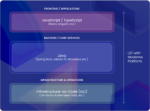Microsoft released Visual Studio 2013 Update 2 CTP 2, adding new capabilities from CTP 1 and providing functionality to help development teams become more productive. Along with the release of 2013.2 comes the release of Microsoft’s programming language, TypeScript. Microsoft first went public with a preview of TypeScript in October 2012, and now it is finally ready to release TypeScript 1.0 RC. The release of TypeScript strengthens it as a first-class development language, according to Microsoft.
TypeScript is designed as a typed superset of JavaScript to strengthen the language and make up for its missing elements. JavaScript doesn’t have any of the application structure concepts such as classes or static typing that are essential to developers when creating larger-scale apps, according to Anders Hejlsberg, Microsoft technical fellow and core developer of TypeScript.
“TypeScript is really about addressing community needs when it comes to writing large JavaScript applications,” he said. “We wanted to see what can we do to add those to JavaScript without messing with the cross-platform capability.”
TypeScript compiles into JavaScript code, which works on any browser, host or operating system. Developers working with TypeScript can use existing JavaScript code, integrate popular JavaScript libraries and be called from other JavaScript code, according to the TypeScript website.
“With TypeScript, we have focused on bridging the wildly popular JavaScript language with types for easy error detection, while bringing forward features from the future version of JavaScript in a way that’s compatible with modern browsers,” wrote Jonathan Turner, program manager for TypeScript, on the TypeScript blog.
Developers using TypeScript are also able to use highly productive development techniques and practices such as static checking, statement completion, code refactoring and symbol-based navigation.
TypeScript, Hejlsberg said, enables projects, multiple files and cross-platform refactoring to “give the look and feel of Java or C++.” He said it also works with jQuery, Node.js or AngularJS with no modifications.
“And it works even better when you define type definitions,” he added. “If you use optional static types for jQuery or whatever you’re using, you get a fantastic tooling experience.”
Google recently released its programming language, Dart 1.0, in November, and while the two languages may look the same on the surface, Dart is meant to spearhead a strategy to replace JavaScript whereas TypeScript is meant to strengthen JavaScript, according to Hejlsberg.
(Related: More on Dart)
TypeScript 1.0 RC will be shipped as an included language in Visual Studio 2013 and will be available as a standalone install for Visual Studio 2012.
A repository of TypeScript’s type definitions is available here.
Other features of Visual Studio 2013.2, provided by Microsoft, include:
• Web/ASP.NET
o Integrates the latest ASP.NET MVC, Web API and Web Page releases from the January release (learn more about it here here)
o New editor for Sass files (learn more about Sass CSS extension here)
o New JSON project items and editor to help developers create or edit JSON files in Web projects
o Integration for new Web Projects that streamlines the use of Windows Azure as a website host from the start
o Various other changes and bug fixes
• Data
o Entity Framework 6.1 Beta 1 is now included with this release, with various improvements (learn more info here)
• Azure
o The sign-in to Visual Studio will now integrate a streamlined Azure activation workflow for MSDN subscribers, making it easier to take advantage of their Azure benefits. When signing in, users who have not yet activated their subscription benefits will be offered an opportunity to do so
o Windows Azure Notification Hubs can send test notification messages to Windows Store, Windows Phone, iOS and Android devices, and can check the outcome in real time
• C++
o Developers can now specify when compiling programs to target latest-generation processors that support AVX2 instruction sets
• Productivity
o New Incoming Changes indicator in CodeLens allows users to see incoming changes from other branches that could impact their code
o Code Maps can visualize IntelliTrace performance events to help identify the path to each of the slowest nodes
• Misc.
o NuGet 2.8 is included in this release (learn more info here)
David Rubinstein contributed to this story.






